|

| |
08/05/2009
ATLANTIS?...
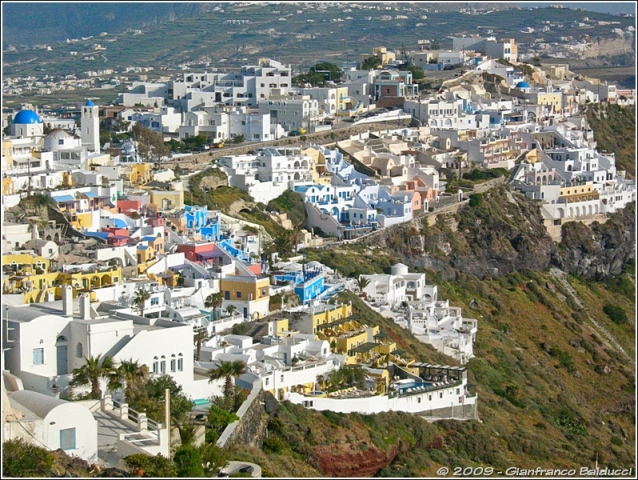
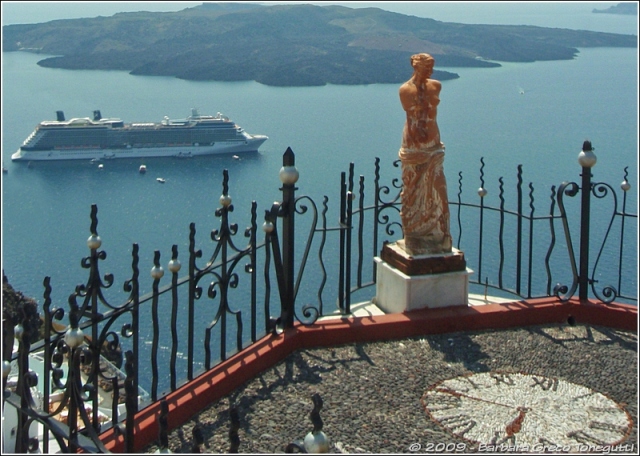
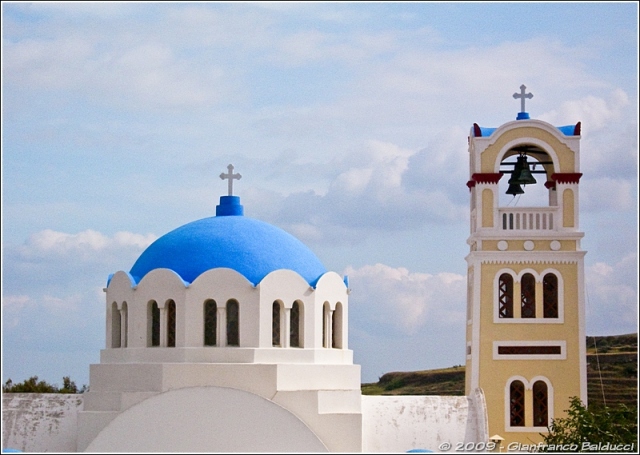
The island of Santorini, or Thira as it is called nowadays, is quite stunning:
it's practically formed only by the edge of a huge caldera, nearly 10 kilometers
in diameter and open to the sea, with the volcano's crater just protruding in
the middle.
The island had already this shape when a rich and sophisticated civilization
blossomed, apparently simultaneously here and in nearby Crete, between 3000 and
1600 years B.C.
This civilization was the superpower of its times in the Aegean, thanks to its
advanced technologies and powerful fleet.
Then, nothing anymore. Both civilizations suddenly declined and, although the two
islands continued to be inhabited, they were much less wealthy and powerful, and
were easily prey of nearby peoples, the Myceneans first (the Acheans of Homer)
and later the Egyptians which at the time were subject to the Persian
rule.
Excavations conducted in the last decades have shown that the settlements on
Thira were destroyed and buried under the volcanic ashes of a huge eruption
which took place around the year 1600 B.C. and which appears to have been
several times more destructive than the infamous explosion of Krakatoa in 1888,
therefore it is believed that also the towns in Crete could have been destroyed
by the combination of earthquakes, tsunamis and ashes, placing a mortal blow on
the economic and social structures of both populations.
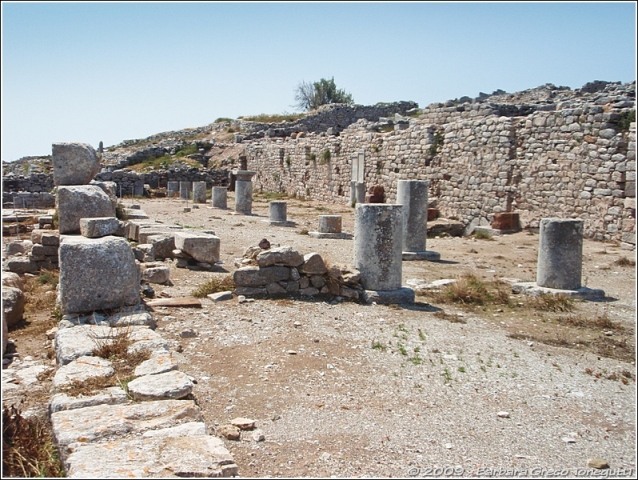
And what about Atlantis? The story is actually third-hand: it's reported by
Plato, who heard it from Solon, who heard it from an Egyptian High priest during
a voyage in 590 B.C., at a time when the Egyptians held a naval base on Thira
and might well have heard some local stories about the disaster of 1000 years
before. Few elements, about a powerful and sophisticated civilization spread
over two island, which was destroyed overnight by Zeus by means of a
catastrophic volcanic eruption: sounds familiar?
11/05/2009
MIKONOS, DELOS...
According to our Pilot Book, in the U.K. Mykonos has become the epitome of an
over-exploited, soul-less place which once was beautiful but not anymore; after
such an introduction, we were naturally approaching the harbour with some
trepidation: will it turn out to be a waste of time?
To be honest, our trepidation was heightened by the numerous ferries and
cruise-ships which were zooming across the bay, heading for the same port as us...
Anyway, once arrived and safely moored alongside the pier, thanks to a very kind
charter-boat skipper who moved his boat to create some space for us, we got
ourselves transportation and started exploring the place! The island is
certainly less dramatic than Santorini, but especially the eastern part, that is
the part farther away from the main town and generally less built, still retains
a quiet charm, with its houses built like white cubes with blue windows, the
many little churches (it is said that there are 365 churches in the island, we
certainly did not check!) and the gentle slopes of the many hills.
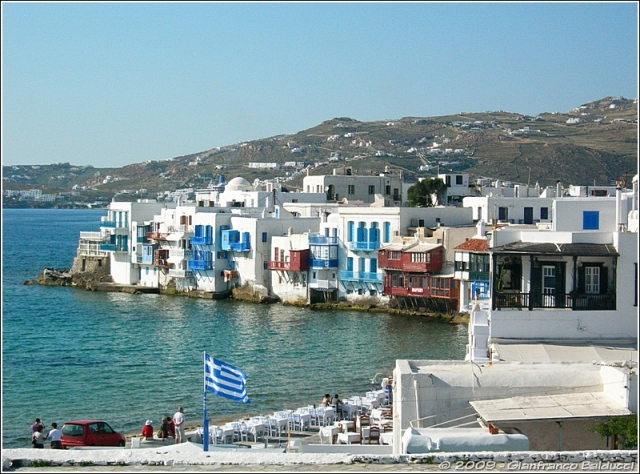
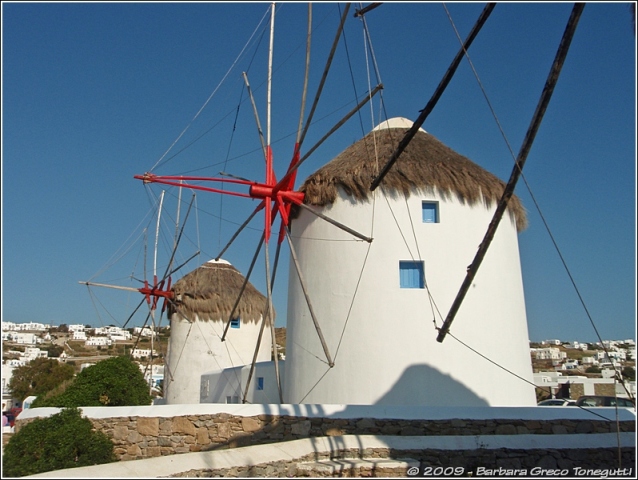
Also the main town turned out to be a surprise: indeed, it's full of shops, a
tavern, a fashion-clothing shop, an expensive jewelry, a souvenir shop, a tavern
- and so on - but the houses and the intricate alleyways, where one gets lost
after walking 10 meters, are charming and pleasant. We liked it a lot, and after
a couple of days we did not get lost very often anymore!
Mandatory trip by boat to the nearby island of Delos, believed by the ancients
to be the birthplace of Apollo and his twin-sister Artemis, and consequently
crowded with temples built by the various Greek cities in competition with one
another. For a relatively short period Delos was also an important and very
wealthy trading centre, but its wealth attracted the attention of the wrong
people, and the town was raided and destroyed a couple of times before being
gradually abandoned in the early years of the Christian Era.
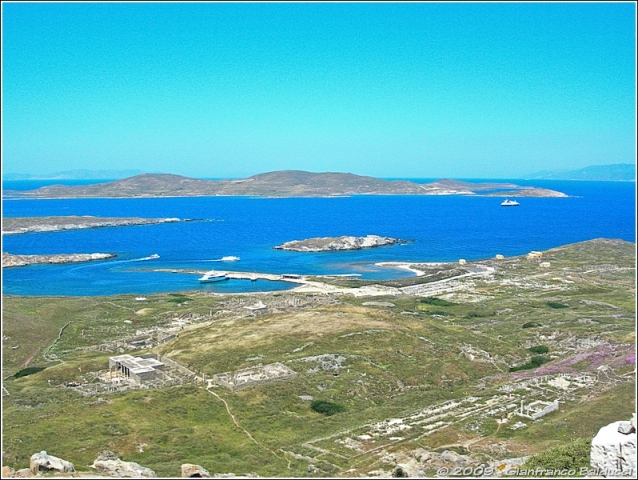
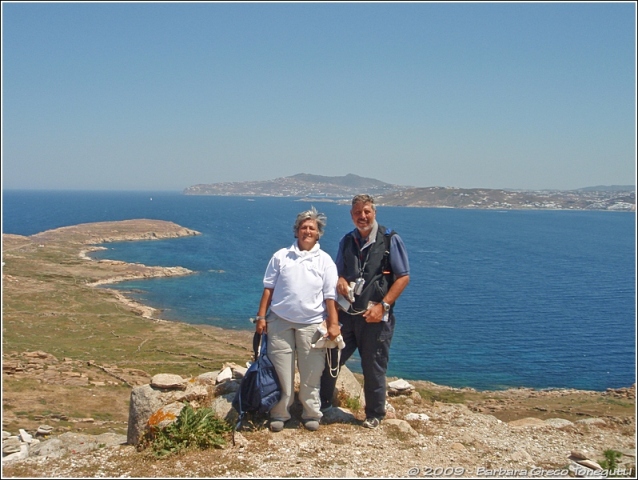
The walk around the town's ruins is interesting, and the view from the hill
where a temple to Zeus used to stand, is breathtaking!
We did like Mykonos, despite the bad reputation; maybe we will find more similarly
charming, albeit less famous (and less crowded!) islands during our voyage. Time
to go, this time no longer towards the north but rather west-bound, towards
Athens and the Corynth Canal.
19/05/2009
Athens, from A like Agora to Z like Zea Marina...
"Athens is the ugliest Capital in Europe" claimed our Pilot Book, which then
added "well, if you are there, take advantage of the stop to go and see the
Parthenon and the National Museum"...
We do not agree too much: indeed, the town is large and uninspiring, mostly made
of concrete boxes built in the last decades, but the historical centre, with its
many roads closed to traffic, is pleasant and the area around the Acropolis is
well arranged. The Parthenon is the main piece, but in reality the whole area
around the Acropolis, the ancient Agora and the various temples are all very
spectacular.
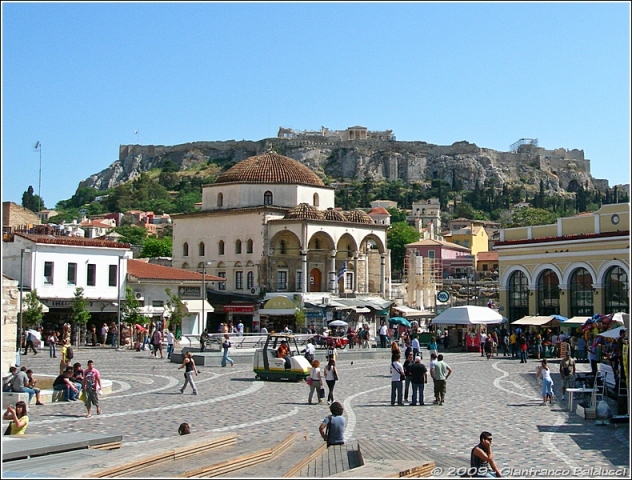
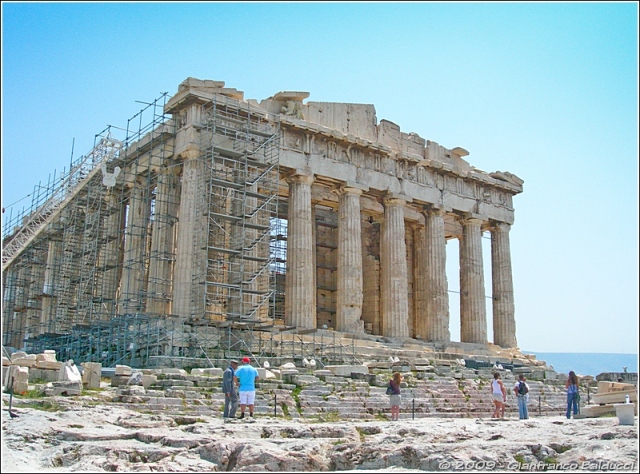
The National Museum is a huge place full of extraordinary pieces of art, it
takes one day just for a very superficial visit!
My preferred item is the bronze statue of Poseidon preparing to throw his
trident (but not all scholars agree, maybe it's Zeus launching a lightning...),
arguably not a very
original choice (but it's always a good thing to please the god of the sea!).
Like several others, this statue has been recovered from the site of an ancient
wreck.
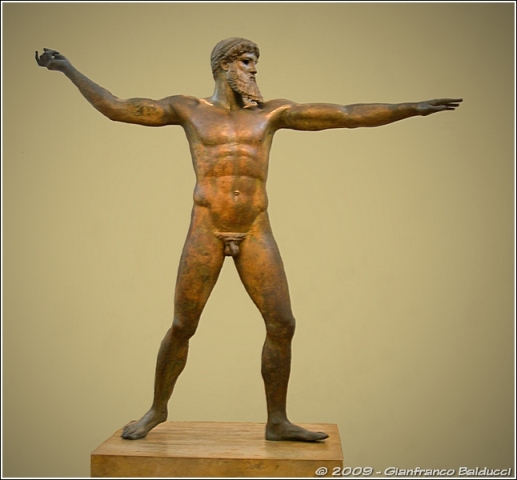
We had nearly decided to skip Athens, in light of the less-than-enthusiastic
remarks of the Pilot Book and of the stated difficulty in finding a mooring in
the area; the expected arrival of bad weather convinced us to give it a try, so
we called Zea Marina and, surprise, we got a place! The Marina is in Piraeus,
quite far from the city centre, but after a couple of days we had fully mastered
the bus and Metro routes around town, so much so that Baby even managed to get
run-down by a speeding car!
Now, after a week's stopover, it's time to leave again, bound for the Corinth
Canal which will allow us a quick transit to the ionian islands that we visited
already in a previous voyage.
28/05/2009
CORINTH...
From Athens, the most logical route towards home goes through the Corinth Canal,
a shortcut that avoids the long tour around the Peloponnese; already in ancient
times ships were carried across the isthmus and Emperor Nero even started
digging a canal, but the works were soon abandoned.
Now the canal has lost much of its importance as large ships cannot get through
and anyway the merchant traffic between Athens and the Adriatic sea is not very
active; we had the impression that yachts account for a major portion of the
whole transits (maybe that's why it's so outrageously expensive!).
From Athens to the Canal one has to sail west for about 30 miles, and once on
the other side there are another 60 miles roughly due west before reaching the
narrows that mark the end of the Corinth Gulf and the beginning of the broad
Patras Gulf.
The area is notoriously windy, so we were not surprised to have strong gusts
blowing out of each valley, going back and forwards between 10 and 30 knots
(hard to have the right amount of sail all the time!).
The actual Canal transit has been good fun, squeezed between two steep cliffs
not much more than 20 meters apart, and we had the Canal all to ourselves, no
other ships or yachts; it's only 3 miles long anyway, so the fun was soon over
and we soon found ourselves battling again with a strong northerly wind.
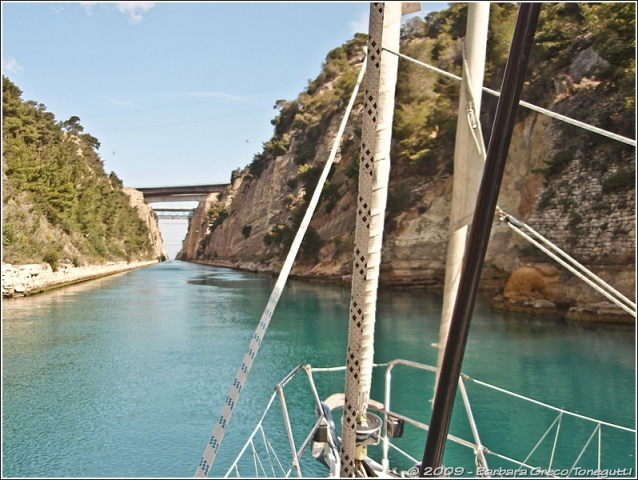
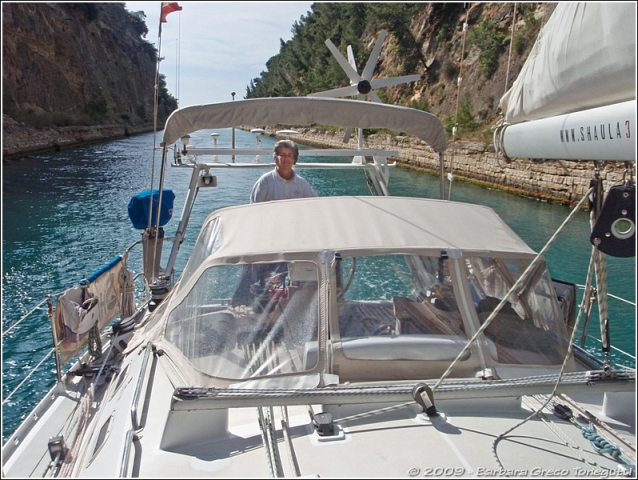
We took shelter in a small cove in the Krissaios Gulf and next morning we
decided to go to the little town of Itea, up inside the gulf, where there is one
of the many un-finished marinas that are all around Greece, and from there we
went to the site of ancient Delphi, located in a stunning scenery on the slopes
of Mount Parnassos. We came back very tired, and finished the day with a dinner
at one of the many tavernas on the seaside.
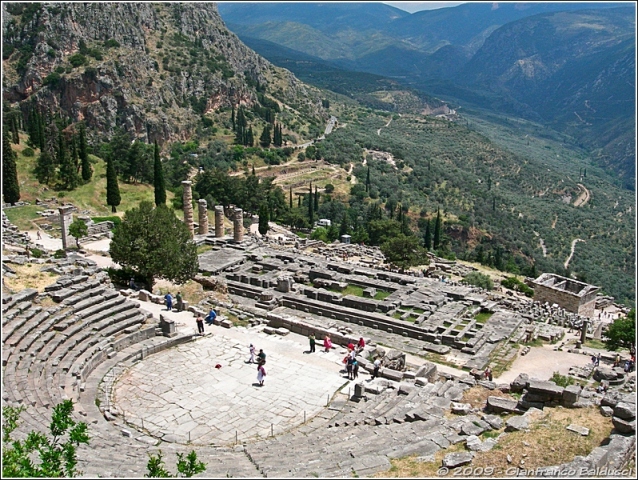
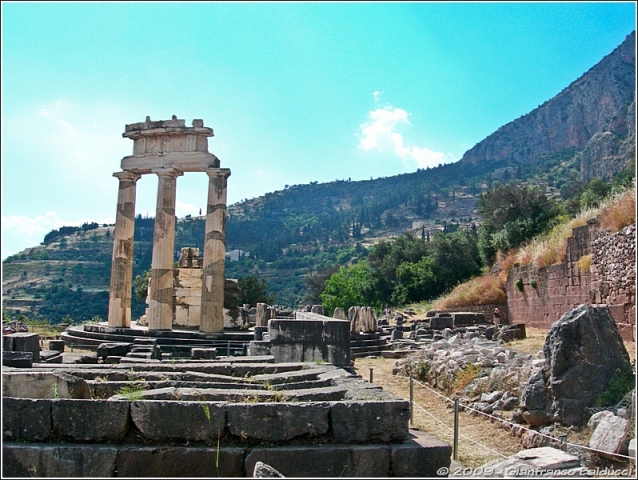
After Itea the wind turned from the west, quite strong and just on the nose, so
we had to wait until the next dawn to rush as quickly as possible towards the
Ionian sea before the wind built up again; the trick worked and already by
mid-morning we were passing under the spectacular suspension-bridge that marks
the end of the Corinth Gulf, and by sunset we were at the little port of Agia
Eyfimia on the island of Kefallinia that we wanted to visit as we skipped it
during previous cruises in the area.
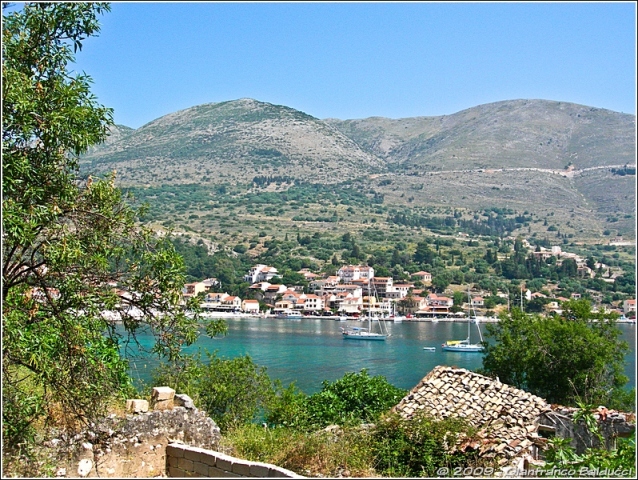
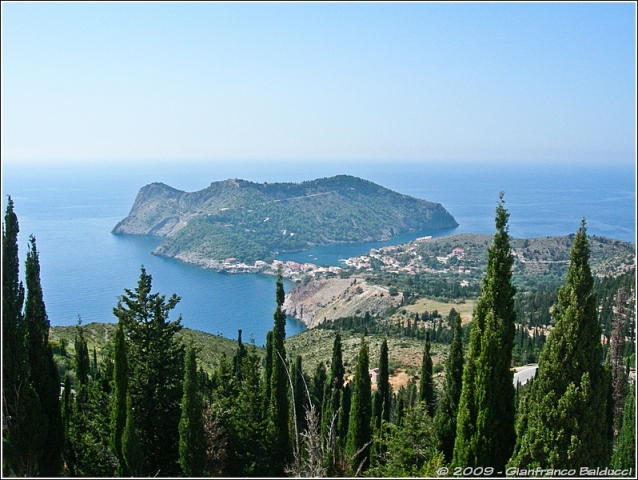
Strictly speaking, we have not yet crossed our departure course, but we are in
waters where we sailed previously, so that was a good excuse to celebrate with a
bottle of Cider.
07/06/2009
THE CIRCLE IS CLOSED...
Even though since some days we were sailing in known waters, we had not yet
crossed the path of this voyage: today we arrived in Brindisi, which we visited
at the departure of the circumnavigation, so the circle is officially closed!
Another 400 miles, and Shaula will finally be lifted out for a bit of
much-deserved maintenance.
20/06/2009
HOME!!
The voyage is over!! After Brindisi, we stopped for a couple of days in Vieste,
where we originally planned to "close the circle", and from there we sailed
straight for Aprilia Marittima, where we put Shaula out of the water for a brief
spell of maintenance work.
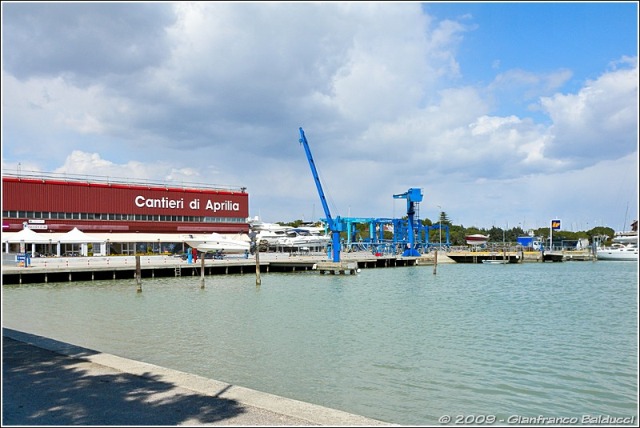
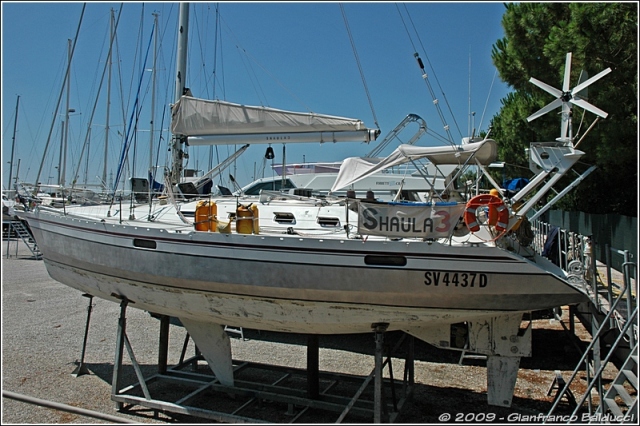
It's a funny feeling being home after nearly two years of absence, and we have a
lot of things to do that will keep us busy for several months! We are also
beginning to think about the next voyages, northern Europe and the French canals
being high on the list!
We will also have to organise our photos (more than 25.000!!) and movies of the
voyage, to select the best stuff, and will have to repair and update the
web-site as well.
READ THE FEEDBACK ABOUT THE
VOYAGE
|